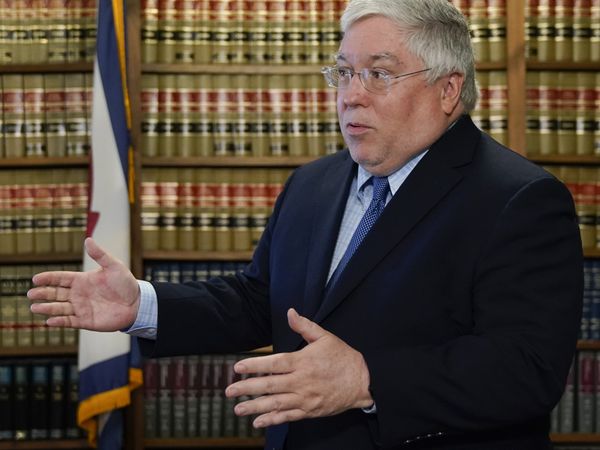
Struggling to understand what’s going on in Australian politics right now? It’s simple: Australia’s right — both its political and media wings — has pivoted hard to the playbook of Republican far-right tactician Steve Bannon: they’re flooding the zone with shit.
It’s a tactic seen in the No case against the Voice to Parliament and the campaign against Brittany Higgins, designed to disorient and overwhelm the media (“the real opposition”, according to Bannon) by drowning its critical instincts under the gusher of stories, feeding its addiction to conflict and gamifying its performative, defensive crouch of “both-sides” reporting.
In Australia, as in the US, there’s a purpose-built spillway: News Corp’s pages get picked up in Liberal Party talking points and pushed on through the amplification algorithms of social media. The Higgins campaign alone has been kept alive through the daily cycle of story-shaped objects on The Australian’s front page.
It’s hard to avoid being swept along. When Nine started to step out of the flood, it too became a target from within — by 2GB’s Ray Hadley (giving The Australian another “story”.)
From the outside, the obsession with relitigating the 2021 scandals seems odd. Reminding us of the grubby details all over again won’t make the Liberals look better, but the opposition will count it as a win if they spread enough shit around to make everyone look as bad as them.
And as the flooding carries all Australian politics down to their level, it meets a deeper purpose: washing the public square clean of diverse voices, particularly those who bring a moral clarity that threatens the right’s vision of the status quo. Even professional journalistic voices such as Lisa Wilkinson or Stan Grant have found no one is immune. But there’s a bigger story we risk missing: all those less well-known — unknown, emerging — voices being pushed out of public debate.
One of the most accessible places for First Nations voices was, once, the IndigenousX Twitter feed. Each week, a different Indigenous person — some already with a media presence, most without — would host the feed, telling their stories from their unique perspective. Last year, it stopped when escalating racist abuse made it just too unsafe. It lives on now in the Reconcile This anthology. (Read it. It’s free. Donate.) Similarly, last month, National Indigenous TV canned its Twitter feed saying it’d “had enough of the racism and hate”.
The right (in the US and in Australia) reckons it’s found a culture war opening in the demands for practical action over discrimination. When #MeToo (and Black Lives Matter) forced a political recognition that sexism or racism is systemic, calling for change, the right saw an opportunity to tag action as “woke”, pushing back against the significant social changes it has hated all along.
The media is being flooded with controversies around the Higgins case, as well as the No case on the Voice. As Wiradyuri man and research fellow James Blackwell told The Saturday Paper earlier this month, it’s shifting the Overton window: the range of publicly acceptable political discourse.
But the right isn’t just trying to make its own once-repugnant views suddenly mainstream. It is working just as hard — maybe harder — to black out the views it opposes, to move the entire window back to somewhere around where it was in, say, 1955. In journalism, it’s found a surprising ally: centrist traditionalists in legacy media who hanker for a past world where they, too, could shelter behind woolly ideas of “objectivity”. Not so long ago, it looked like the “moral clarity” school was winning out.
This past January, the Walter Cronkite School at Arizona State University produced a major report, “Beyond Objectivity“, on “how to produce trustworthy news without ‘objectivity’”. In April, Wesley Lowery, who coined the phrase “moral clarity” in a 2020 tweet, urged journalists through the Columbia Journalism Review to abandon “performative neutrality, paint-by-the-numbers balance, and thoughtless deference to government officials”.
Now the traditionalists have hit back, with calls to reclaim old-style “objectivity” from Lowery’s former editor at The Washington Post Marty Baron, and recently retired New York Times executive editor Dean Baquet who described journalistic “objectivity” as “a process that was created to make sure everybody’s baggage did not skew coverage”.
There’s history to the debate: back in 2019, when Baron was still editor, he censured Lowery (then a Pulitzer prize-winning reporter on the masthead) over “overtly political” tweets. After Lowery left the Post, he tweeted over a later internal row at the paper: “Reporters of colour shouldn’t have their jobs threatened for speaking out about mainstream media failures to properly cover and contextualise issues of race.”
When Opposition Leader Peter Dutton dismissed The Age’s Indigenous affairs correspondent and Birpai man Jack Latimore as “some activist journalist” — in order to disregard a report that Liberal members were misquoting former High Court judges on the Voice — he was, wittingly or not, nodding to the trope that journalists of colour, unlike white journalists, cannot be professionally, journalistically, “objective” when writing about race.
It was just another indicator that there’s no dry land in objectivity from the bad-faith flooding of the media zone.







